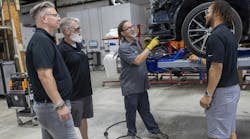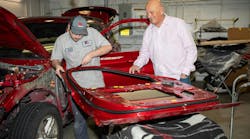Auto manufacturer information is available for nearly every step of the repair process: disassembly, body and structural work, refinish, and post-repair quality assurance. Repairers must constantly refer to them for every procedure on every car because designs are changing faster than technicians can be trained.
There are an estimated 242 vehicle types that will be re-engineered, redesigned, or introduced as brand-new models over the next three years, says Bill Stage, senior director of development for I-CAR. And those changes are driving updates in required methods for panel attachment, welding, equipment, tools, materials and diagnosis.
With so much repair information available, reliance on your memory just doesn’t cut it these days. So habitual reference to OEM resources are critical for quality, accurate and efficient work to be produced at your facility daily.
The Problem
Failure to refer to OEM processes is a trend that’s surprisingly common throughout the country, Stage says. Some technicians don’t have time to search for the information, some don’t know where to look, some don’t know what types are available, and others simply don’t know the information even exists.
Without the information, Stage says technicians tend to make repair decisions based on guesses, past experience or memory. They start cutting, heating, welding and installing components to try to repair things, but they’re not always accurate. Vehicle updates are made so frequently that many of the processes technicians knew of yesterday are no longer relevant today.
That results in several common repair mistakes, he says, such as improper methods for heat application, sectioning, bonding, riveting and restraint system installation. That leads to poor efficiency, cycle time, comeback and customer satisfaction numbers, as well as safety and liability issues—problems that will eventually have a negative impact on sales performance.
“Relying on memory to repair the vehicle will no longer guarantee compliance with OEM procedures,” Stage say. That’s true even for seasoned veterans. “With the technology utilized in constructing today’s vehicles, you cannot safely repair them without access to the information. Sometimes, you can’t repair them at all,” he says.
What You Need
There are more than 20 million pages of OEM repair information available to collision repairers, says Dan Espersen, senior product marketing manager of collision for ALLDATA. The issue for many technicians is the time-consuming task of sifting and sorting through the documents. Here are three main areas that your technicians should learn to find quickly and have on hand at all times:
1. Restraint system updates: Vehicle restraint systems are regularly modified, even within the same model. Without procedural information, technicians are susceptible to making installations that endanger safety systems throughout the car. Douglas Gan, president of Airbag Solutions, points to the Honda FIT as an example. The 2007 and 2008 FIT restraint system used a pre-tensioner in the belt and an anchor on the driver side. In 2009, Honda altered that to only a pre-tensioner on both the driver and passenger side.
2. Material identification: Several new types of high-strength materials are present on new model vehicles—such as steels, aluminum, and in the future, carbon fiber. Technicians must identify the type, location, dimensions, hardness, strength and tolerance of every material because they require updated repair methodology.
“You cannot continue to apply the same old methods and logic in today’s environment,” Stage says. “There are just too many types of materials and construction used in every vehicle.”
Consider this 2013 Honda Accord (pictured left). The B-pillar is 1500 MPA ultra-high-strength steel, Stage says. It can’t be heated in order to maintain its strength. In addition, where the bottom of the B-pillar meets the rocker panel is an area that requires MIG brazing. Without knowing that, technicians would perform a different outdated process that is likely to weaken the component.
“That would change the vehicle’s crash test rating,” Stage says. “Occupants won’t be as protected as they should be in a future wreck.”
3. Vehicle complexity: Vehicles are not designed solely of one type of material. That means each component of the car cannot be repaired the same way. So knowing the type and location of each material used is crucial.
Look at this 2013 Dodge Dart (right). The design features six different types of materials—mild steel, high-strength steel, advanced high-strength steel, press-hardened steel, aluminum and plastic—each of which has its own specific required processes.
Espersen says material identification and associated repair methods are among the most important pieces of information for technicians to have easy access to today. But that’s not all. Here’s a look at a few other areas that can dramatically vary between vehicle models where updated information is required:
• Structural and panel attachment methods, and required tools and materials to perform the process
Even with all these resources available, Gan says it can still be a time-consuming task for technicians to dig through websites and find the information they need. They often feel they don’t have time, which sticks technicians in a dilemma between cycle time and supplement issues.
“Shops want to do the right thing, but are finding it difficult to sort through it all,” Gan says. “Shops don’t know where to look, haven’t got time to look, and need the information immediately.”
He suggests the industry needs a simpler solution that provides shops with direct connections to information that pertains to the repair they’re performing.
Fortunately, I-CAR will soon launch a new initiative to ease technicians’ searches for information. The organization is developing a centralized database for all published OEM procedures to create easier and affordable access for shops. The structure for the effort has not yet been determined, but Stage says it will make acquisition of OEM processes much more efficient.
• Welding equipment, weld types, consumable materials and locations
• Fastener locations and types
• Sectioning information
• Sealer and foam locations
• Necessary specialty tools, equipment and materials; sometimes specialty adhesives, rivets, glues, mechanical fasteners or drill bits may be required
• Diagnosis and repair of mechanical parts and systems
• Diagnosis and repair of the vehicle electronics, accessories, component locations, ground locations, wiring diagrams and diagnostic trouble codes
Obtain Access
Even when technicians know they need OEM repair information, Stage says they don’t always know where to look. He suggests a few resources to utilize during your daily routine:
• OEM websites: All auto manufacturers host repair information and technical bulletins on their own websites. Some information is free and some is subscription-based. Shops can purchase short or long-term access to fee-based information from the sites.
• OEMOnestop.com: Repairers can visit this website and be directed toward information for all auto manufacturers.
• Information providers: The three major estimating companies—Audatex, a Solera Company, CCC Information Services Inc. and Mitchell International have all made developments to build OEM procedures into their systems. Stage says they have developed tools that all shops should take advantage of, such as automatic integration of information within estimates.
• ALLDATA: ALLDATA is a single entity that compiles both collision and mechanical OEM repair information into a software package. Visit the company’s website, alldata.com, for more information.
• Airbag Solutions: Airbag Solutions is an online resource that compiles vehicle restraint system information and procedures for all auto manufacturers. Visit airbagsolutions.com for more information.
• I-CAR: I-CAR’s website offers resources for vehicle maker technical information. All auto manufacturers are listed, and highlight whether the information is free or paid.
Stage says there are some repair processes that OEMs don’t have available information for.
In those situations, I-CAR has developed widely accepted methods that technicians are encouraged to use. Visit i-car.com for more information.



